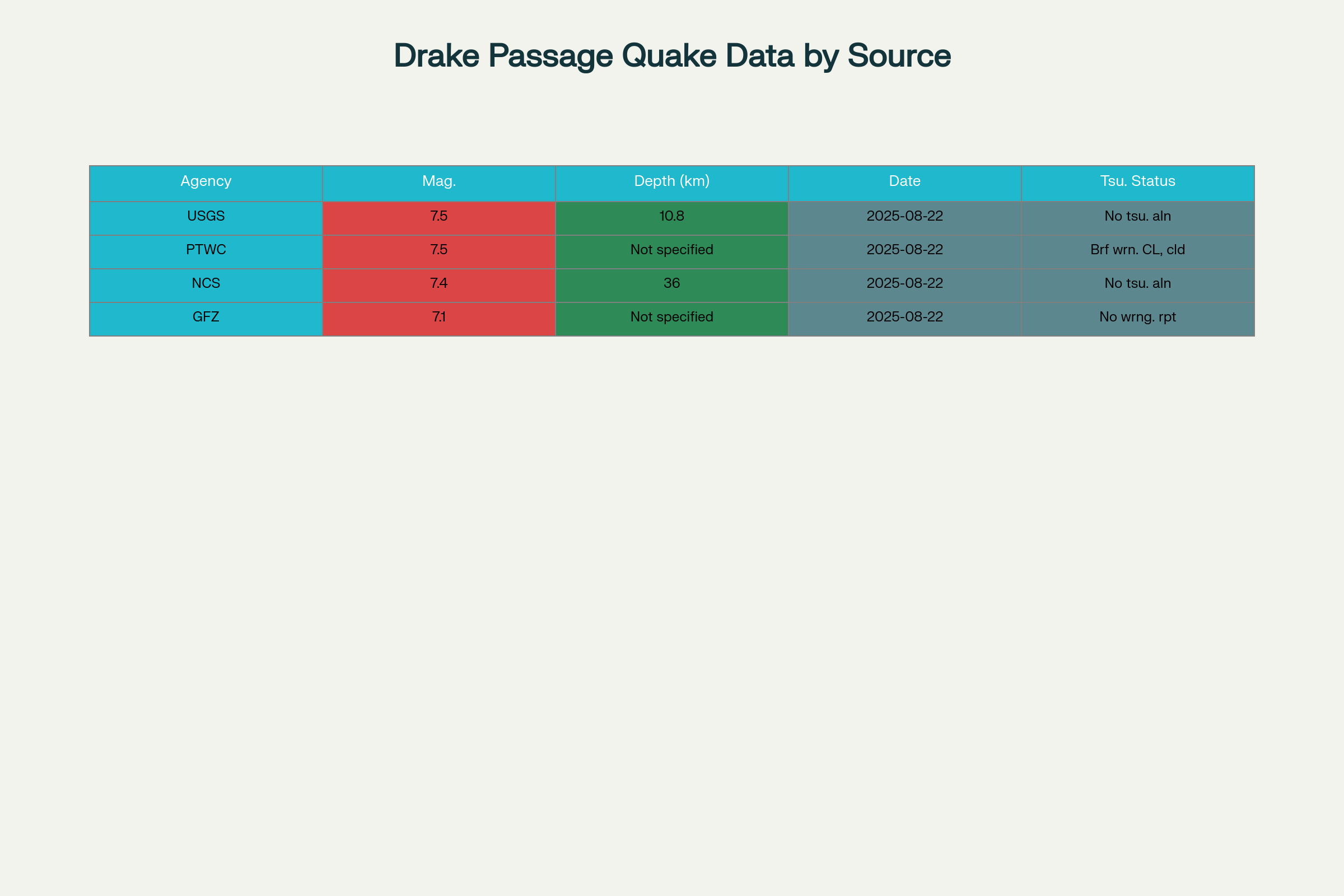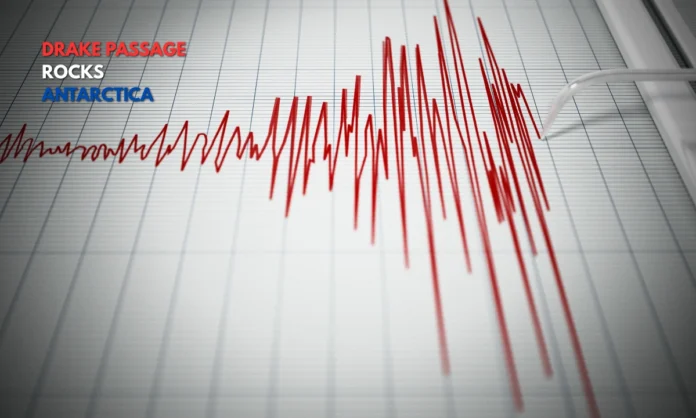Key Highlights:
- A powerful 7.5-magnitude Drake Passage earthquake struck on August 22, 2025, initially reported as magnitude 8.0 by USGS before being downgraded
- The seismic event occurred at 02:16:19 UTC (7:46 AM IST) at a shallow depth of 10.8 kilometers beneath the seafloor
- Chilean authorities issued brief tsunami precautions for Antarctic territories following the event, but no significant tsunami threat materialized for populated regions
Drake Passage Earthquake: Seismic Event Details and Initial Response
A powerful 7.5-magnitude Drake Passage earthquake shook the remote waters between South America and Antarctica on Thursday, August 22, 2025, marking one of the most significant seismic events in this tectonically active region. The United States Geological Survey initially reported the tremor at magnitude 8.0 before downgrading it to 7.5 following detailed analysis. This significant seismic event occurred at 02:16:19 UTC (7:46 AM Indian Standard Time) at a relatively shallow depth of 10.8 kilometers beneath the ocean floor.
The tremor struck in one of Earth’s most isolated regions, with the nearest populated settlement being the Argentine town of Tolhuin in Tierra del Fuego province, located approximately 707 kilometers away with a population of 9,879 residents. The epicenter was positioned roughly 258 kilometers northwest of Chile’s Base Frei Antarctic research station. Despite its significant magnitude, the remote location meant minimal immediate impact on populated areas, though it triggered precautionary tsunami alerts for Chilean Antarctic territories.
Emergency response protocols were immediately activated across multiple nations following the initial reports. Chilean naval authorities coordinated with international monitoring agencies to assess potential impacts on research stations and maritime operations in the Southern Ocean. The isolated nature of the affected region complicated initial damage assessments, requiring coordination between Argentine and Chilean research facilities to confirm the absence of immediate structural damage or personnel injuries.
Drake Passage Earthquake: Geographic Significance and Tectonic Setting
The Drake Passage represents one of the world’s most geologically significant waterways, stretching approximately 800 to 1,000 kilometers between Cape Horn at South America’s southern tip and the South Shetland Islands near Antarctica. This critical oceanic channel connects the southwestern Atlantic Ocean with the southeastern Pacific Ocean, serving as the narrowest waterway circumnavigating Antarctica. The Drake Passage earthquake occurred within this tectonically complex region where the South American Plate and Antarctic Plate interact through active fault systems and fracture zones.
- The passage opened millions of years ago when Antarctica separated from South America due to plate tectonics, with estimates ranging from 49 to 17 million years ago
- The Shackleton fracture zone lies beneath the seafloor in this zone, contributing to ongoing seismic activity that can generate significant tremors
The region experiences considerable tectonic stress due to the ongoing divergence between continental plates that originally created this waterway. The area’s complex geological structure includes multiple fault lines and seafloor fracture zones that make it particularly susceptible to major seismic events. This seismic activity is further complicated by the passage’s role in hosting the Antarctic Circumpolar Current, the world’s strongest ocean current, which moves massive volumes of water through the region unimpeded by land masses.
The tremor’s shallow depth of approximately 11 kilometers places it within the upper oceanic crust, where tectonic stress accumulates along active fault systems. This geological setting explains why the event initially registered such high magnitude readings before being refined through detailed seismological analysis. The specific location along the Scotia Ridge system contributes to the region’s heightened seismic activity, with this latest event adding to the historical record of significant tremors in the area.
Drake Passage Earthquake: Tsunami Assessment and International Response
Following the Drake Passage earthquake, multiple international monitoring agencies activated their tsunami warning systems to assess potential coastal threats. The Pacific Tsunami Warning Center initially issued a brief warning for Chilean coastal areas, stating that hazardous tsunami waves were possible within three hours along some Chilean coasts. However, this warning was quickly canceled as wave modeling indicated minimal tsunami generation from the tremor.
- Chile’s Navy Hydrographic and Oceanographic Service issued precautionary measures for Chilean Antarctic territory following the initial magnitude 8.0 reading
- The U.S. National Tsunami Warning Center confirmed minimal tsunami threat to United States territories
Different seismological agencies reported varying measurements for the seismic event, reflecting the challenges of real-time analysis in remote oceanic regions. While the USGS settled on magnitude 7.5 at 10.8 kilometers depth, India’s National Center for Seismology recorded the event as magnitude 7.4 at 36 kilometers depth. The German Research Center for Geosciences measured the tremor at magnitude 7.1. These variations are common in initial assessments, particularly for events occurring in remote oceanic areas.
New Zealand’s National Emergency Management Agency and GNS Science conducted independent assessments and determined that the seismic event was unlikely to generate tsunami waves affecting New Zealand shores. This comprehensive international response demonstrates the global monitoring capabilities for significant tremors, even when they occur in the world’s most remote waters. Advanced buoy networks and satellite monitoring systems provided real-time data that enabled rapid threat assessment and public safety decisions.
Drake Passage Earthquake: Regional Context and Scientific Implications
The Drake Passage earthquake occurs within a broader context of South American geological activity, where the western and northern coasts experience high hazard levels due to active subduction zones. According to USGS seismic hazard assessments, regions including Chile, western Argentina, Peru, Ecuador, Colombia, and Venezuela face elevated risks that can produce damaging ground shaking. The tremor, while significant in magnitude, occurred in a location with minimal exposure to populated areas or critical infrastructure.
- South American seismic hazard models indicate the highest risks along subduction interfaces where oceanic plates meet continental margins
- The region represents a transitional area between major tectonic provinces where unique geological processes create complex stress patterns
Historical seismic data shows that large tremors (magnitude 7.0 and above) occur regularly throughout South American waters, including the remote region where this event struck. Modern monitoring networks enable rapid detection and analysis of such events, providing crucial data for tsunami warning systems and scientific research. Advanced ground-motion prediction models and real-time seismic networks ensure that even tremors in isolated areas are quickly detected and assessed for potential hazards to distant populations.
The August 22 Drake Passage Earthquake event adds to the growing database of seismic activity that helps scientists understand tectonic processes in this remote but geologically significant region. Research teams from multiple countries utilize data from events like this to improve understanding of deep ocean geological processes and their potential impacts on climate systems and ocean circulation patterns.

Drake Passage Earthquake: Closing Assessment
The August 22, 2025 Drake Passage earthquake represents a significant occurrence that highlights both the dynamic geological processes between South America and Antarctica and the effectiveness of modern monitoring systems. While the initial magnitude 8.0 reading caused brief concern and triggered precautionary tsunami warnings, the revised magnitude 7.5 assessment and subsequent analysis confirmed minimal threat to populated regions.
The Drake Passage Earthquake tremor’s occurrence in one of Earth’s most remote waterways demonstrates how major tectonic activity continues to shape the boundaries between continents and oceans. Despite its impressive magnitude, the remote location meant that its primary impact was scientific rather than humanitarian, adding to researchers’ understanding of Southern Hemisphere seismic activity while causing no reported casualties or significant damage. This event serves as a reminder of the ongoing geological forces that continue to reshape our planet’s most isolated regions, providing valuable insights into the complex interactions between tectonic plates in polar environments.


